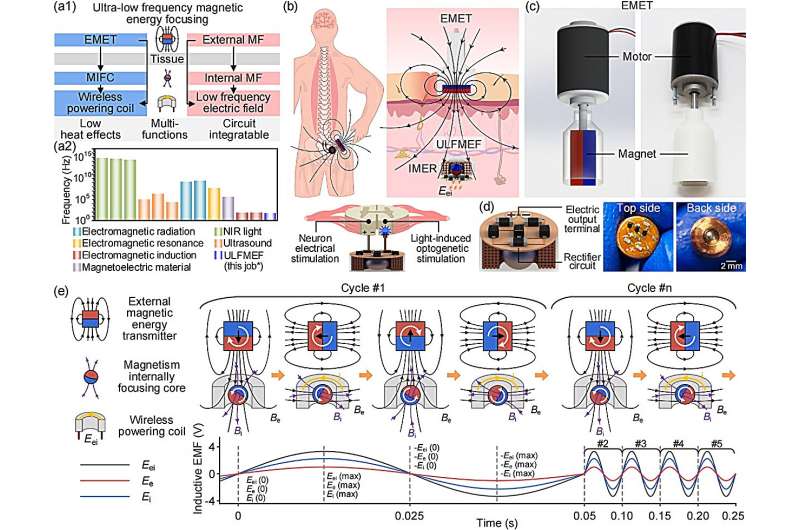This article has been reviewed according to Science X's editorial process and policies. Editors have highlighted the following attributes while ensuring the content's credibility:
fact-checked
trusted source
proofread
Long-distance and low-attenuation magnetic energy focusing technology for deep-tissue wireless powering

Fully implantable electronic devices such as cardiac pacemakers, cardiovascular monitors and deep brain stimulators, have been widely developed in medical monitoring, diagnosis, and treatments. Existing implantable devices are based on power supply through replaceable batteries, self-powering supply, and wireless power transfer. The key challenge for disposable batteries is the limited life, which requires intermittent replacement via surgery, resulting in non-negligible health risks and medical costs.
Self-powering supply involves the conversion of endogenous energy in the organism into electric energy through the circulatory, respiratory, and digestive systems. However, restricted organ movements, weak power, and unstable energy collection also present challenges. By contrast, wireless transcutaneous energy transfer techniques have been developed to transfer external energy to power implanted electronic devices across biological tissues.
Currently, external energy sources, including ultrasound, near-infrared light, heat and magnetic field, have been used for wireless energy transfer. However, the ultrasound and high-frequency magnetic field can be easily absorbed or reflected by the skin and tissue. The light and heat always result in thermal damage and severe energy attenuation through tissues. Therefore, these techniques generally suffer from issues of low energy transfer efficiency for thicker tissues, while low-frequency (< 100 Hz) magnetic fields, due to their high biosafety and slow attenuation rate, have become an ideal source of energy.
Writing in National Science Review, Prof. Xi Xie and Prof. Lelun Jiang are the first to propose a methodology of ultra-low frequency magnetic energy focusing (ULFMEF) for highly effective and robust wireless-powering of deep-tissue implantable electronic devices.
The magnetic energy transfer system mainly consists of an implantable magnetic energy receiver (IMER) and a portable external magnetic energy transmitter (EMET). The EMET generates an external magnetic field at ultra-low frequencies and the MIFC generates an internal magnetic field. The combined magnetic fields induce a low-frequency electric field in the wireless powering coil.
Compared with other high-frequency technologies, such as the photovoltaic and electromagnetic effects, the ULFMEF system takes advantage of the ultra-low frequency magnetic field with low heat effects and multi-functions. The magnetic-core IMER was fabricated by encapsulating a NdFeB magnetism internally focusing core (MIFC) with high magnetization strength embedded inside a cylinder copper coil, where additional circuits or stimulation electrodes were connected to the wireless powering coils.
The portable magnetic energy transmitter consists of a DC motor coupled to a speed controller to drive the rotation of a NdFeB magnet. The top side and back side of the IMER have a size of Φ 8×4 mm3 and a weight of only ~ 1 g. A miniature electric circuit was integrated on the top side to rectify the generated Eei-induced alternative current into direct current and boost the voltage.
The portable transmitter can generate a rotating magnetic field at ultra-low frequencies from 5 Hz to 50 Hz via the rotation of the motor-driving NdFeB magnet, where the rotating magnetic field penetrates the biological tissues and induces the electricity of the IMER through two pathways. In the external pathway, the rotating magnetic field of the transmitter can induce a magnetic flux change and generate an external magnetic field-induced electric potential Ee in the coil. Also importantly, in the internal pathway, the MIFC synchronously rotates with the external magnetic field due to the strong magnetic interaction between the driving magnet and MIFC.
This results in the in-situ rotating magnetic field inside the coil and produces the internal magnetic field-induced electric potential Ei. The total generated electric potential Eei in the IMER consists of the Ee and Ei, where the existence of the MIFC in IMER can remarkably enhance the total output electricity compared to conventional magnetic energy transfer.
In contrast to other wireless energy transfer methods, this ULFMEF methodology significantly increases the transmission distance and slows down the attenuation rate during the energy transfer. Moreover, this low-frequency and long-distance magnetic energy transfer mode of ULFMEF can penetrate the deeper biological tissues with minimal energy loss and thermal damage.
This holds promise for the effective power supply of implantable microelectronic devices to perform electrical stimulation or optical stimulation in deep tissues. The effective, robust, and versatile features of the ULFMEF render this methodology as a highly promising wireless powering technology for a new generation of fully implantable biodevices.
More information: Yuanyuan Li et al, Ultra-low frequency magnetic energy focusing for highly effective wireless powering of deep-tissue implantable electronic devices, National Science Review (2024). DOI: 10.1093/nsr/nwae062





















